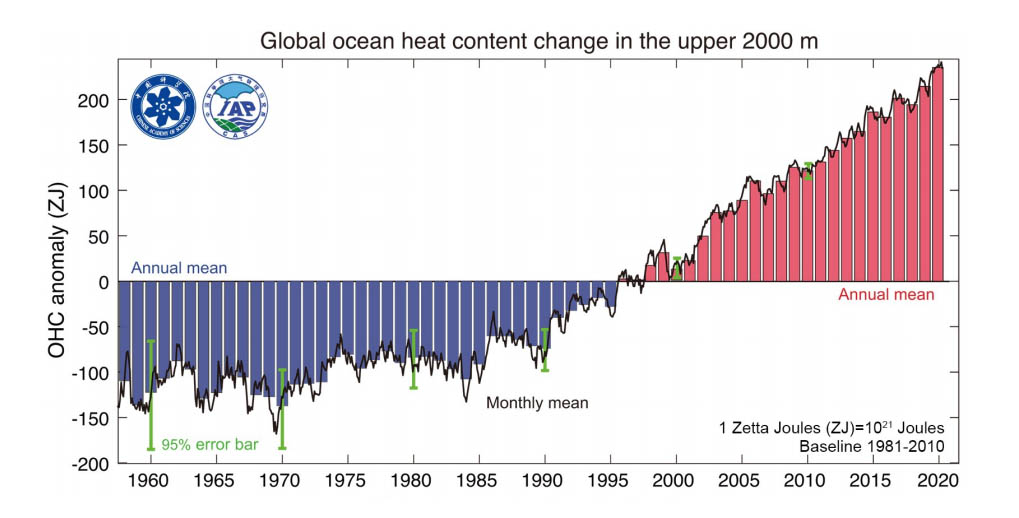2020 was a record-breaking year for ocean heat
Warmer ocean waters contribute to sea level rise and strengthen storms
Jan 13, 2021 - by Laura Snider
The NSF NCAR Mesa Lab will be closed Thursday, Dec. 18, and Friday, Dec. 19, due to extreme winds and power outages.
View more information.Jan 13, 2021 - by Laura Snider

The heat content in the upper 2,000 meters of the ocean from 1958 through 2020. The graph shows the departure from a baseline (the average temperature between 1981-2010), with red bars showing more heat than the baseline and blue bars showing less. Image: Advances in Atmospheric Science
The temperatures in the upper 2,000 meters of the ocean hit a record high in 2020, according to a new analysis by a research team that included scientists from the National Center for Atmospheric Research (NCAR). The five hottest years for the upper ocean on record have all occurred since 2015.
The results of the new analysis, published in the journal Advances in Atmospheric Science, further illustrate how Earth is warming — just over 90 percent of the additional heat due to human-caused climate change is absorbed by the ocean. Ocean heat is a valuable indicator of climate change because it does not fluctuate as much as temperatures at the Earth’s surface, which can vary in response to weather and natural climate variations such as El Niño. Thus it more clearly reveals the gradual accumulation of heat due to human activities.
The increase in ocean temperatures can cause a number of societal impacts. Warmer ocean surface waters can, for example, supercharge hurricanes and other storms that travel over the sea. Warmer water also expands to take up more room, driving sea level rise and causing coastal flooding.
The uneven vertical heating of the ocean — the surface warms more quickly than the deeper ocean layers — also causes the ocean to become more stratified. This stratification inhibits ocean mixing and the distribution of dissolved oxygen and nutrients, which impacts marine ecosystems and fisheries.
“The warming of the ocean has real consequences,” said NCAR scientist Kevin Trenberth, a co-author of the study. “Ocean heat has exacerbated many of the most significant climate-related events in recent history, and contributed to the record number of billion-dollar disasters in the United States in 2020.”
The new research was led by Lijing Cheng, of the Chinese Academy of Sciences. The NCAR contributors are Trenberth and John Fasullo.
The research was supported by the National Science Foundation, which is NCAR’s sponsor, as well as by the National Key R&D Program of China, the Chinese Academy of Sciences, NASA, and the U.S. Department of Energy.
Ocean heat is challenging to analyze because direct measurements of the ocean’s temperature and other attributes can be few and far between. Scientists depend on models to help fill in the gaps between these measurements. However, a network of ocean floats deployed in the last couple of decades that move throughout the top 2,000 meters of the open ocean has provided researchers with valuable data for better understanding past measurements and calibrating their models.
For this analysis, the scientists used two different ocean heat datasets, one from the Institute of Atmospheric Physics, which is part of the Chinese Academy of Sciences, and one from the National Centers for Environmental Information, which is part of the U.S. National Oceanic and Atmospheric Administration.
While the two datasets yielded slightly different values for the globally integrated ocean heat in 2020, they both found that 2020 was the warmest year on record. The results also agree with results from independent research teams using slightly different methods and from independent data, such as satellite measurements of global sea level.
“Despite the challenges of measuring the entire ocean’s temperature, we can now say definitively that the ocean is warming and has been for decades,” Fasullo said. “In fact, each decade back to the 1970s has been discernibly warmer than the decade before, revealing an accumulation of heat that can only be explained by human activities.”